Archive for the ‘Ice Dam Removal’ Category
Tuesday, December 13th, 2016
Ice Dams on Mansard Roofs Can be a Seriously Big Headache to Remove
Roof Styles Affect Ice Dam Severity
As discussed in Case Study #16, there can be some serious problems if homeowners decide to remove snow from only a portion of the roof plane affected by ice dams. We call it the ‘Double Dam’, which refers to the fact that ice dams can grow much further up the roof when only lower sections of snow are removed (commonly done with roof snow rakes because they can’t reach high enough on the roof).
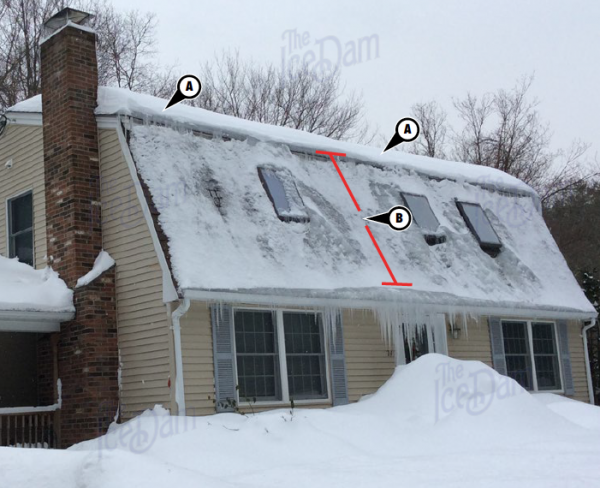
Mansard roofs, such as this one from Edina, Minnesota, can create massive ice dams when the steep pitch (B) is cleared of snow. This is amplified when the slope has directional bias towards the north because the sun will not help melt the ice as it accumulates. In the photo, below, we see two ice dam problems on this Edina mansard roof. The traditional location (A) is exacerbated by the low roof pitch (Case Study #09 explores the relationship between roof pitch, or roof slope, and ice dams). Area B has an ice dam that covers the entire span of the roof slope. This took many hours to remove even with our commercial ice dam steaming equipment.
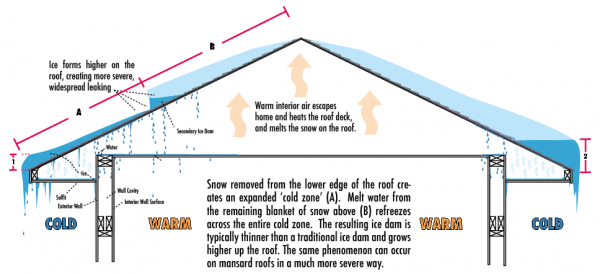
Which Ice Dam Do You Want?
Ice dam #1 is not the one you want. Ice dams like this take hours to remove with steam, which is the most efficient and safe method for removing ice dams. This ice dam is thin but it has grown many feet up the roof. Ice dam #2 is an easier problem to resolve.
To read more Case Studies click here.
Tags: about ice dams, best ice dam removal in minneapolis, best rated ice dam removal contractor, edina ice dam removal, edina ice dam steaming, highest rated ice dam removal company in minneapolis, ice and snow removal, ice dam expert, ice dam heat cable, Ice dam heat tape, ice dam prevention, ice dam removal jerks, identifying an ice dam, is my ice dam bad, mansard roofs and ice dams, relationship between styles of roofs and ice dam formations, removing ice dams with steam, removing massive ice dams, roof ice steaming, roof pitch and ice dam relationship, roof styles and severity of ice dams, twin cities ice dam remover
Posted in Ice Dam Prevention, Ice Dam Removal, Ice Dams, Misc., Ice Dams: General Info | Comments Off on Mansard Roof Ice Dams
Monday, December 12th, 2016
What Frost Melt Patterns Can Tell You About Your Home
Insulation and Ice Dams
At their most fundamental level, ice dams are the result of the interaction of heat loss and snow on your roof. An experienced Ice Dam Company Thermographer can use photos like these in conjunction with infrared imaging to see the weak points in your home’s thermal envelope. If you have a moment on the next frosty morning, take a few photos of your roof from a few angles before the sun hits it. Those photos may end up saving you time and money if you are hoping to fix the root cause of ice dams and home heating inefficiencies. Of course, ice dam prevention involves more than simple insulation job, but understanding the basics through frost pattern analysis, thermal imaging and a good site inspection is a great place to start.
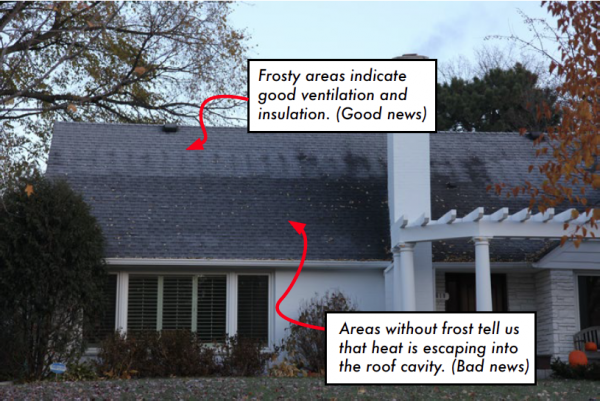
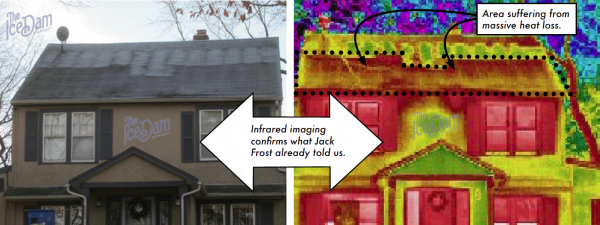

To read more Case Studies click here.
Tags: about ice dams, best ice dam removal in minneapolis, best rated ice dam removal contractor, highest rated ice dam removal company in minneapolis, ice and snow removal, ice dam expert, ice dam removal jerks, minneapolis ice dam removal, thermal inspection, water damage
Posted in Ice Dam Prevention, Ice Dam Removal, Ice Dams, Misc., Ice Dams: General Info, Water Damage | Comments Off on Ice Dam Prevention: Go Thermal
Thursday, December 8th, 2016
Observations on the Effectiveness of Ice Melting Compounds on Ice Dams
Can Dad’s Old Pantyhose Save Your Home?
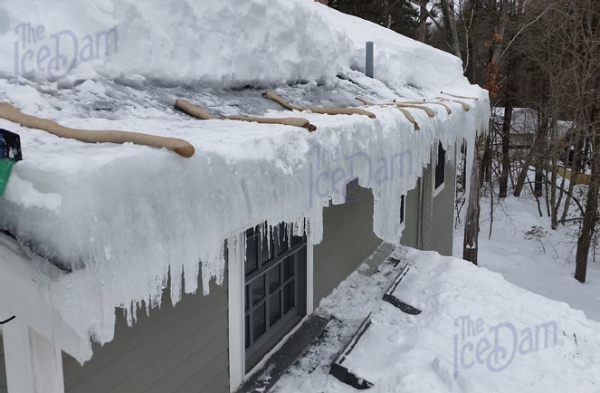
Over the past 25 years we have seen many different methods used to address ice dams. More often than not those measures are reactive, not proactive. Thus is the case of the lowly salt sock, otherwise known as a cloth tube of some sort filled with an ice melting compound of some sort.
Salt socks work on the principle that the ice melting compound is contained in a linear form which, when laid across an ice dam, will melt a channel through the ice. That path would then presumably be used as an escape route for water that may tend to get trapped behind the ice dam. The purpose of the sock is to hold the ice melting material in place, thereby concentrating the melting action. (Yes, that was a cross-dressing joke about dad).
Concept Vs. Reality
The only problem with the sale sock is that it simply doesn’t work. The examples below show typical results. In theory, salt socks seem like a great idea. In practice, however, using them to deal with an ice dam is not practical. One problem is that in order for them to do their intended job (Cut channels through the ice dam) they need to be placed somewhere meticulously, every 16″ or so. That’s a lot of socks. Next, we see that they tend to only melt about 90% down through the ice dam and then putter out. We have no idea why they don’t melt a clean slot right down to the roofing material but it never happens? The net result is that the melt water that causes ice dams, and the leaks that follow, still can not find a way off the roof. That’s bad. Perhaps the most dangerous part of using salt socks (outside of balancing on a ladder to position them all perfectly) is that they create a false sense of hope. Homeowners tend to ‘install’ them and not look back. That is, until water is dripping through the ceiling.
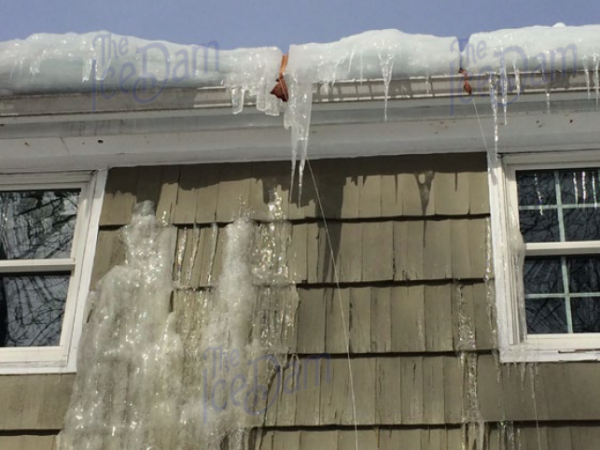
These salt socks didn’t melt down to the roof, resulting in massive water damage to the interior walls. (Can you find the ice on the siding?)
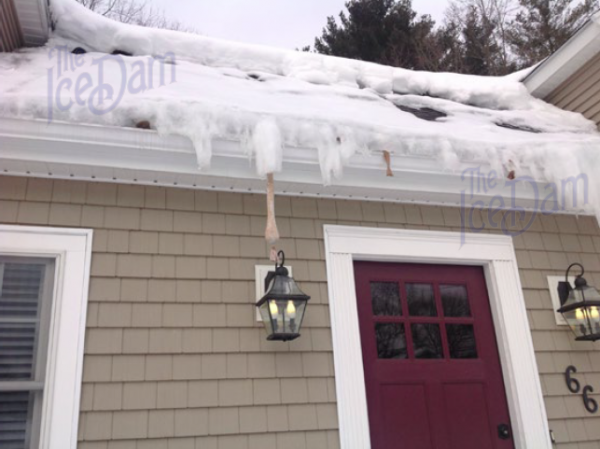
Sad and ineffective pantyhose, encased in ice.
Here’s the bottom line: Don’t use salt socks or pantyhose filled with ice melting compounds to manager your ice dam problem. It simply doesn’t work.
To read more Case Studies click here.
Tags: about ice dams, best ice dam removal in minneapolis, best rated ice dam removal contractor, highest rated ice dam removal company in minneapolis, ice and snow removal, ice dam expert, ice dam heat cable, ice dam removal jerks, ice dam removal with pantyhose, pantyhose and ice dams, right vs wrong way to remove ice dams, salt socks and ice dams, signs of an ice dam problem, twin cities ice dam remover
Posted in Ice Dam Prevention, Ice Dam Removal, Ice Dams, Misc., Water Damage | Comments Off on Salt Socks, Pantyhose and Ice Dams
Thursday, December 8th, 2016
How Roof Pitch (Roof Slope) Affects the Impact of Ice Dams on Standard Residential Construction
Fact: The Flatter the Roof, the Less Ice it Takes to Cause Problems
As discussed in previous Ice Dam Company blogs and Case Studies, there is a strong relationship between roof slope and the timing and likelihood of damage as the result of ice dams. Specifically, low roof slope areas are far more susceptible to damage by small ice accumulations than areas of steeper slope. Why? It comes down to basic geometry. Study the diagrams, below. You can see that the high slope roofs (C) require a pretty thick ice dam to form before water will begin leaking into the home. Eave depth plays another important role. See Case Study #10 for more information.
Ice dams create leaks when melted water from higher on the roof slope hits a dam of ice and is forced to travel backwards, up and under the plus of the roofing system (typically asphalt shingles). When that backward motion occurs outside the plane of exterior wall (dotted red lines in diagrams), the water runs down the exterior wall or through the soffits (zone indicated by happy face). As soon as the water falls on top of the top plate of the wall it seeps down through the wall causing damage to insulation, finishes and flooring (zone indicated by sad face). Truthfully, water coming through your soffits is nothing to be happy about. The next step is the interior of your home so it is considered an emergency in terms of the progression of the ice dam. As mentioned before, if you see ice coming through the soffit or down the exterior wall, it’s time to get that ice dam removed.

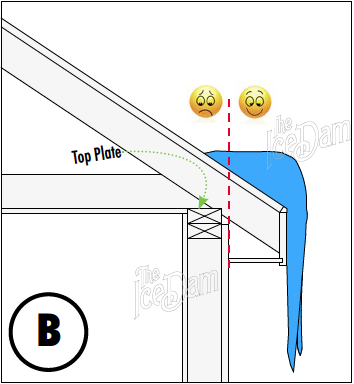
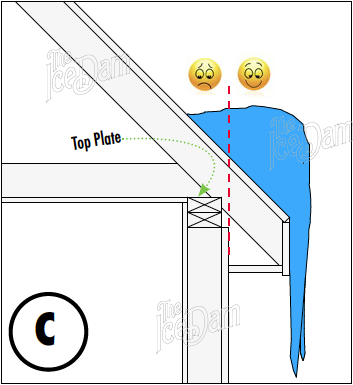
Wayzata Residence with Low Pitch Roof Suffers the Consequence
Seen below is a home in Wayzata, Minnesota where we steamed an ice dam a couple of years ago. The construction assembly was typical 2×6 walls, 12″ eaves, 6″ facia with a 2/12 roof pitch. From the ground, no ominous, threatening icicles could be seen, just a couple of pathetic whiskers of ice off the face of the gutter through the soffit (D). Pan out and you see that the entire exterior wall was bleeding ice through the siding. This is bad. This home had massive damage to the interior insulation, drywall and flooring systems.

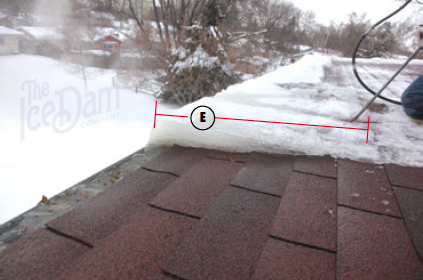
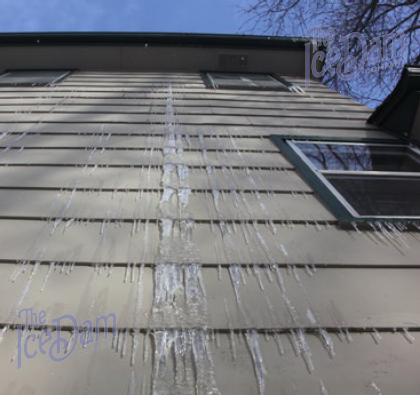
As discussed in Case Study #06, low pitch roofs also tend to create ‘deeper’ ice dams (E), where the ice has grown further up the roof. Deep ice dams take far longer to remove.
Three take-aways:
- No icicles does not mean no ice dams.
- Low pitch roofs present higher risks in terms of how quickly small ice dams can cause big problems.
- Ice or water coming down the exterior wall in below freezing conditions is bad. Very, very bad.
To read more Case Studies click here.
Tags: about ice dams, best ice dam removal in minneapolis, best rated ice dam removal contractor, commercial ice removal, edina ice dam removal, edina ice dam steaming, highest rated ice dam removal company in minneapolis, how do I know I have ice dams, ice and snow removal, ice dam expert, ice dam heat cable, ice dam prevention, ice dam removal jerks, twin cities ice dam remover, wayzata ice dam removal
Posted in Ice Dam Prevention, Ice Dam Removal, Ice Dams, Misc., Ice Dams: General Info, Water Damage | Comments Off on Roof Pitch and Ice Dams: Part 1
Monday, December 5th, 2016
1. Water Damage
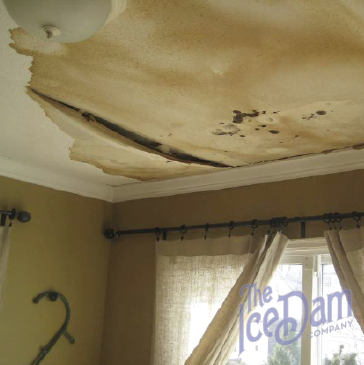
2. Ruined Insulation
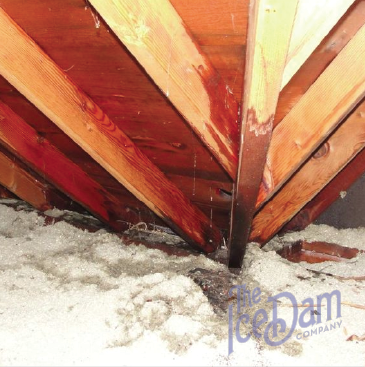
3. Mold and Mildew
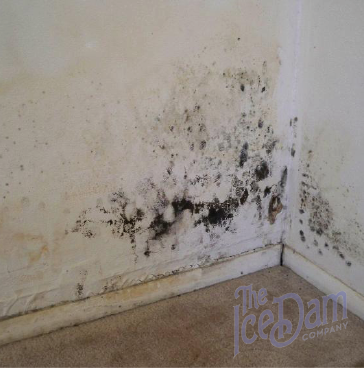
4. Gutter Damage
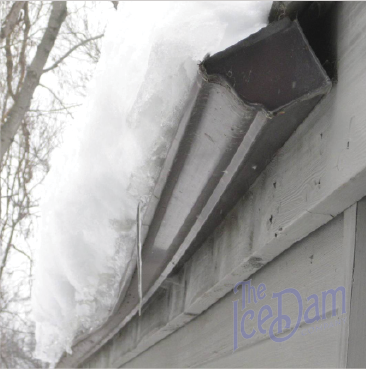
5. Property Damage
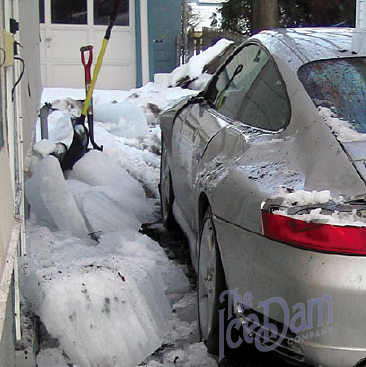
6. Soffit Damage
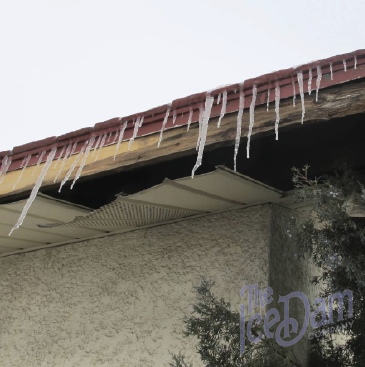
7. Landscaping Damage

8. Falling Ice
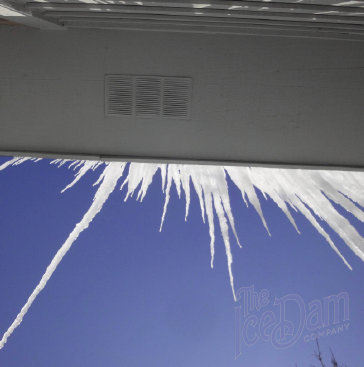
9. Flooring Damage
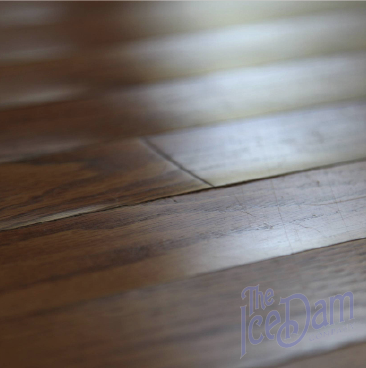
To read more Case Studies click here.
Tags: about ice dams, best ice dam removal in minneapolis, best rated ice dam removal contractor, commercial ice removal, edina ice dam removal, edina ice dam steaming, gutter deicing wire, highest rated ice dam removal company in minneapolis, how do I know I have ice dams, how to file an insurance claim for an ice dam, ice and snow removal, ice dam expert, ice dam removal jerks, minneapolis ice dam removal, orono ice dam removal, roof ice steaming, twin cities ice dam remover, wayzata ice dam removal
Posted in Ice Dam Prevention, Ice Dam Removal, Ice Dams, Misc., Ice Dams: General Info, Water Damage | Comments Off on 9 Common Types of Ice Dam Damage
Thursday, December 1st, 2016
How Much Should it Cost to Have an Ice Dam Removed: Ice Dam Steaming Costs Explained by The Ice Dam Company
Ice Dam Removal: Pricing Vs. Cost
As mentioned in Case Study #05, there is a big difference between price and cost when trying to figure out how much your ice dam removal project will cost. The price is what someone tells you over the phone, normally relating to what they charge per hour for their ice dam removal services. We made a list of the 8 most common factors in determining the cost of ice dam removal in Case Study #05. Here is an examination of one major driver in ice dam removal cost: The depth of the ice dam.
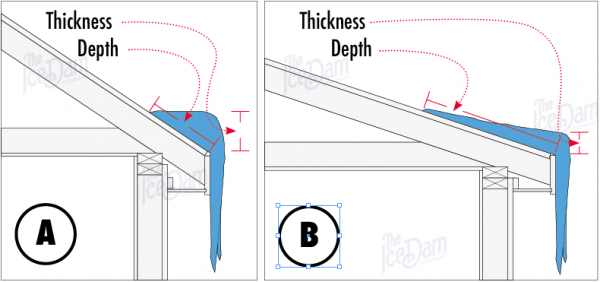
Which takes longer to remove?
Intuition might suggest that thicker ice dams (A) take longer to remove then thinner ice dams (B). Not true. The main factor in the ice dam removal cost is how far up the roof the ice has grown. We refer to this as the ‘depth’ of the ice dam. Deeper ice dams take much longer to remove than those that are thick but shallow.
Estimating the Cost of Ice Dam Removal by Steam
You might think that after having removed thousands of ice dams around the country over the past 25 years we would be able to provide an accurate estimate over the phone as to how long a project might take. Sadly, we can’t. Anyone offering a guaranteed timeframe for ice dam removal projects over the phone is frankly full of it. We know that we can often remove between 10-15 feet of ice dam as measured along an eave every hour after the equipment is set up (C), below left. We know that there are many factors that determine the ultimate length of the ice dam steaming time, as discussed in Case Study #05. One of the main project timeframe drivers is ice dam depth and it can not be known until an experienced eye sees it and that can’t be known until the snow has been removed from the area. Until the ice dam is fully exposed it is impossible to know how long it will take to remove it. In the photos below, the ice dam on the right took three times longer to steam off than the ice dam on the left, even though it was 1/3 the thickness and the roof was a ‘walker’. It’s all about how far up the roof the ice has grown.


To read more Case Studies click here.
Tags: about ice dams, best ice dam removal in minneapolis, best rated ice dam removal contractor, edina ice dam removal, highest rated ice dam removal company in minneapolis, ice and snow removal, ice dam expert, ice dam heat cable, ice dam prevention, Ice dam removal, minneapolis ie dam removal, twin cities ice dam remover
Posted in Ice Dam Prevention, Ice Dam Removal, Ice Dams, Misc., Ice Dams: General Info | Comments Off on Ice Dam Removal Cost
Tuesday, November 1st, 2016
Steaming Ice Dams is the Fastest, Safest Way to Remove Ice Dams in Minneapolis
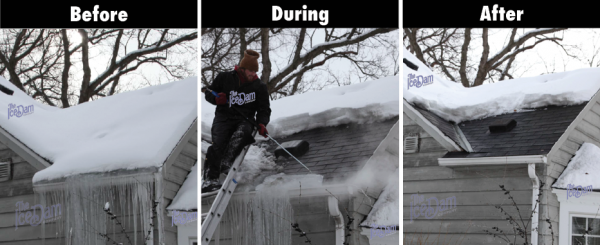
Why Use Steam?
When used properly, a commercial ice dam steamer is the best way to quickly and safely remove an ice dam or other unwanted ice accumulation. Like anything else, it’s possible to use a steamer improperly and damage property. That’s why you should hire an experienced ice removal company. Far more common is damage done to roofs using high temperature pressure washers. Most of our competitors that claim to be using steam are actually using high temp pressure washers. It’s the dirty little secret in our industry. Want to know the easiest way to tell the difference between a steamer and a high temperature pressure washer? If the gun has a trigger, it is NOT a steamer. It’s that simple. More information about Ice Dam Steamers vs High Temp Pressure Washers can be found here.
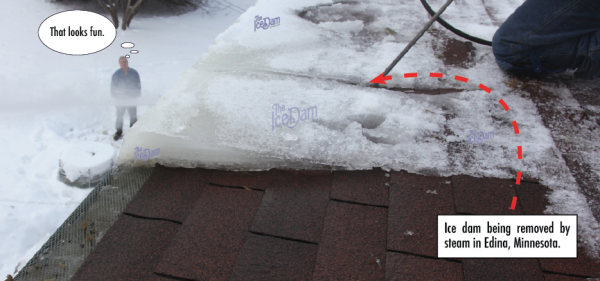
Ice Dam Company is a certified member of IDSAFE : the Ice Dam Steaming Association For Education.

Ice Dam Steaming Association For Education
To read more Case Studies click here.
Tags: about ice dams, best ice dam removal in minneapolis, best rated ice dam removal contractor, edina ice dam removal, edina ice dam steaming, highest rated ice dam removal company in minneapolis, ice dam removal jerks, ice removal company, ice removal professionals, lake minnetonka ice dam removal, minnepolis ice dam removal, orono ice dam removal, roof ice steaming, signs of an ice dam problem, twin cities ice dam remover, wayzata ice dam removal
Posted in Ice Dam Prevention, Ice Dam Removal, Ice Dams, Misc., Ice Dams: General Info | Comments Off on Ice Dam Removal by Steam
Saturday, October 1st, 2016
There is a lot of misinformation out there on the topic of ice dams. Our goal here is to be the single definitive source for all things relating to ice dams. Towards that end, here are some common misconceptions about ice dams, roof snow, roof ice and gutter ice removal.
FACT: Ice dams can occur with virtually no snow on your roof. It’s a question of ice accumulations. It takes very little actual moisture to form ice dams. Even a dusting of snow can create a problem. Of course it is most often the case the thick snow accumulations create ice dams more quickly, but don’t be fooled into complacency because it’s a low snow season. See Case Study #09.
FICTION: Gutters have something to do with ice dams. The truth is gutters have nothing whatsoever to do with ice dams. See Case Study #03 for proof. If your home is prone to ice dams you will get them regardless of whether or not you have gutters. If you have gutters they will fill with ice and provide a foundation for the ice dam above. True. If you don’t have gutters, the ice dam simply builds on the cold edge of the roof. We provide ice dam removal for many homes each year that do not have gutters. In fact, some of our repeat clients have removed their gutters upon the advice of a dumb person only to be shocked that the ice dams came back the season after. Whoops.
FACT: Gutter systems can be damaged by ice. We see it every year. A section of otherwise fine gutter is either on the ground or hanging pathetically off the edge of the roof, filled with ice. Ice weighs about 60 pounds per cubic foot and gutters are not designed to tolerate that sort of load. It’s important to initiate gutter ice removal sooner than later for this reason. See Case Study #11 for common ice dam damage.
FICTION: When it comes to insulation, the more the better. Improperly insulated homes are just as bad as under insulated homes when it comes to ice dams. We have fixed countless bad insulation jobs for this reason. Specifically, we frequently find insulation done in such a way as to inhibit proper ventilation. Moreover, if you don’t address air leakage into the attic or rafter spaces, all the insulation in the world won’t prevent ice dams. See Case Study #04 for details about good eave ventilation.
FACT: You can’t always see ice dams from the ground. It’s true that you can often spot a monster ice dam quite quickly. It’s easy to spot the two foot icicles and the little adjoining glacier on your gutter. The sneaky ones are usually above skylights or in roof pan areas far out of sight. Sometimes ice dams grow up valleys and on top of dormers making it almost impossible to identify from the ground. See Case Study #02 for more information on where ice dams form on residential homes.
FICTION: Salt socks are a smart way to address ice dams. People use pantyhose, old socks and store-bought cloth tubes filled with a variety of ice-melting compounds for removing ice dams. Corrosive substances like rock salt, sodium chloride, calcium chloride, magnesium chloride and more to melt channels through their ice dams. Some compounds are better than others, but all present risks you should keep in mind. Some of the aforementioned chemicals affect the integrity or color of your roof, some are corrosive to the aluminum when gutter ice is removed this way, some are corrosive to valley metal and other flashings, some damage plant life as the water drains below. You are rolling the dice when you go this route so be aware. See Case Study #13 for more information on salt socks (salt in pantyhose).
FACT: Ice should be removed by steam. Here is the skinny. We are roofers and have fixed hundreds of roofs that have been damaged by well-intentioned professionals with hammers, picks and hatchets in their pursuit of removing ice dams to help their clients. The damage we have found caused by the less-than-professional souls is almost funny if it wasn’t so serious. In our years we have seen jobs with picks and hammers where removing ice dams was done successfully. It get’s down to the question of whether you want to take that risk? We strongly advise against the hack-a-teer approach even if it is a little cheaper. Roof Ice and Gutter Ice should always be removed with steam.
FICTION: Ice dams need to be thick to cause a problem. Ice dams as thin as one inch can cause big problems. A good general rule is that the steeper your roof, the thicker the ice dam has to be to cause problems. On lower pitched roofs even a thin ice dam can hurt.
FACT: The leaking caused by ice dams may not show up right away. It would be nice if water stains or mold manifested immediately upon entering your home but it simply does not work that way. Often the water that ice dams push into homes travels around wall and ceiling cavities, trapped by vapor barriers and other materials until it finds the path of least resistance to escape. By the time you see water inside, it’s usually been there for a while, which results in mold and mildew.
To read more Case Studies click here.
Tags: about ice dams, best ice dam removal in minneapolis, best rated ice dam removal contractor, commercial ice removal, edina ice dam removal, edina ice dam steaming, gutter deicing wire, highest rated ice dam removal company in minneapolis, how do I know I have ice dams, ice and snow removal, ice dam expert, ice removal professionals, minneapolis ice dam removal, twin cities ice dam remover
Posted in Ice Dam Prevention, Ice Dam Removal, Ice Dams, Misc., Ice Dams: General Info, Water Damage | Comments Off on 10 Ice Dam Facts: Ice Dam Myths Explored
Sunday, July 3rd, 2016
The Factors that Determine Ice Dam Removal Cost and Pricing
Ice Dam Removal Pricing
Generally speaking, you can expect to pay somewhere between $300 to $600 per hour for ice dam removal with steam. As much as you may not want to hear this, with over 25 years of experience behind us, we can tell you that the primary driver for ice dam pricing is classic supply and demand. Every market will have a different demand for ice dam removal and a different supply of qualified contractors to perform that work. (See Econ101 from your freshman year for further details). Back to the word “qualified”. There are dozens of companies in the Twin Cities market right now who are using ice picks and hammers and axes to remove ice dams. They normally charge less per hour than ice dam steaming contractors. There are also scores of competitors using high temperature pressure washers and calling them steamers (hint: 2 of the top 3 Google results in Minnesota). Yikes. In the Minneapolis market we profit by following the work of the aforementioned “professionals” by repairing the damage they’ve done each winter with pics and pressure washers. It’s hurts to pay for ice dam removal. It’s extra painful to pay for repairing the damage left behind by losers.

Ice Dam Removal Speed
There are many factors that go into determining how long an ice dam takes to remove:
- Roof height (Higher = More difficult)
- Roof pitch (Steeper = More difficult)
- Snow load (More snow = More time)
- Site protections time (Property under the work area needs to be protected to prevent damage from falling ice and snow)
- Ice dam thickness (Thicker = More time)
- Ice dam depth (The further it has grown up the roof, the longer removal takes)
- Outdoor temps (Colder = More difficult)
- Ethics (Lower ethics = More time spent)
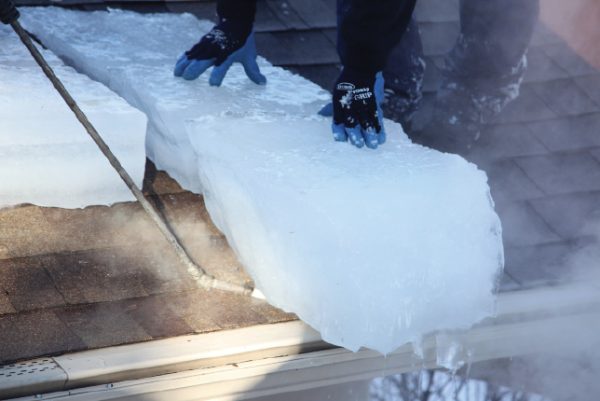
Having two members to the crew is not only important to safety, it is essential for efficiency. One guy cuts and one guy throws the ice chunks.
To Chunk or Not to Chunk
There is a big difference between ice dam removal COST and ice dam removal PRICING. Pricing is what one typically pays per hour for the work to be performed. Cost relates to how long it takes to do the job. In our list of the 8 factors that determine ice dam removal cost, #8 is the most important. That’s what the photos in this case study are meant to illustrate. Ethical ice dam removal guys do it like shown and they use steam, not high temperature pressure washers. It’s called ‘chunking’. The idea is simple. Use the steamer to cut the ice dam into chunks that can be picked up and thrown off the roof. Cutting ice is the part of the job that takes the longest. Add to cutting time, add to the job cost. The alternative is to use the steamer-or pressure washer if you’re totally smarmy-to methodically melt away ALL of the ice from the roof, one square inch at a time. As shown here, one only needs to actually melt about 5-10% of the ice in order to remove the ice dam. Make slots and undercut. It’s that simple. What the less ethical players do is also simple. Melt all of the ice, milk the clock and watch the dollars add up.
To read more Case Studies click here.
Tags: about ice dams, best ice dam removal in minneapolis, best rated ice dam removal contractor, commercial ice removal, edina ice dam removal, edina ice dam steaming, highest rated ice dam removal company in minneapolis, ice and snow removal, ice dam expert, ice dam removal jerks, ice removal company, minneapolis ice dam removal, roof ice steaming, twin cities ice dam remover
Posted in Ice Dam Prevention, Ice Dam Removal, Ice Dams, Misc., Ice Dams: General Info | Comments Off on List of Ice Dam Removal Cost Factors
Wednesday, June 22nd, 2016
The Truth About Gutters and their Relationship with Ice Dams
In 2011, Ice Dam Company owner Steve Kuhl wrote a nationally published article about ice dams for the Journal of Light Construction. One of the topics that receieved the most attention was the notion that gutters have nothing to do with ice dams. Here is a deeper look at that assertion.
There is a great deal of confusion and misinformation about the relationship between gutters and ice dams. Many people are under the misconception that gutters cause ice dams or that gutters filled with ice can cause water to back up into homes. Not true. We repeat. Gutters have nothing to do with ice dam formation or severity. For this reason, buying systems that heat gutters in order to prevent ice dams is a total and complete waste of money.
We know that ice dams occure when:
- Escaped heat from the inside of the home warms the roof deck.
- Melting snow results in water that runs down to a cold, unheated area of the roof (frequently the eave, as shown below).
- That water freezes, forming ice. After many of these cycles, that ice piles up to form an ice dam.
Study the illustrations below. These are identical eave designs, one with gutters, the other without. The Area B in the diagrams below is referred to as the ‘cold edge’ of the eave because heat from the interior of the home doesn’t travel that far. Fact One: Whether or not a home has gutters, a cold edge will still exist and this is where ice dams form. Fact Two: leaks from ice dams occur in Area A, at the leading, top edge of the ice dam where water–with nowhere else to go–is forced up under the roofing material and into the home. Put another way, if the home in Figure 2 had bad leaks inside, those leaks would not be eliminated whatsoever if we took a chainsaw and cut off the gutters along the red dashed line (C). Moreover, if we heated the gutters using a fancy electrical system, the likelihood of ice dams and the subsequent leaking would NOT be affected. Spend money on heat cables for the lower edge of your roof, not on heating the gutters only. High quality heat cables can be quite effective in preventing ice dams.
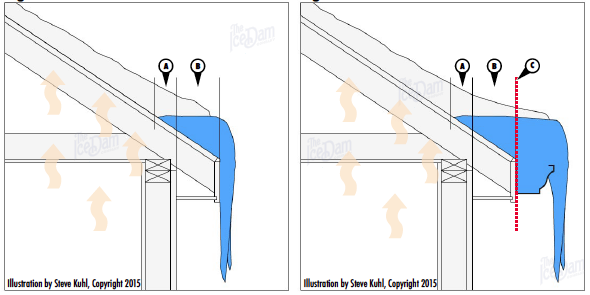
Figure 1: Ice Dam Without Gutters; Figure 2: Ice Dam With Gutters
None of this is to suggest that ice in gutters are harmless. We have seen many gutters damaged or destroyed by ice dams and that is a problem most homeowners would like to avoid. The point here is that, all else held equal, if a home is likely to get ice dams the addition or deletion of gutters will be of no consequence to the formation or severity of said ice dams. Likewise, for this reason, installing heated gutters or adding heating systems to existing gutters will have no affect whatsoever on the occurrence or severity of ice dams.
To read more Case Studies click here.
Tags: about ice dams, best ice dam removal in minneapolis, best rated ice dam removal contractor, commercial ice removal, edina ice dam removal, highest rated ice dam removal company in minneapolis, how do I know I have ice dams, how to tell if an ice dam is a problem, ice dam expert, ice dam removal jerks, identifying an ice dam, minneapolis ice dam removal
Posted in Ice Dam Heat Tape, Ice Dam Prevention, Ice Dam Removal, Ice Dams, Misc., Ice Dams: General Info | Comments Off on Ice Dams in Gutters: A Myth in the Making





































